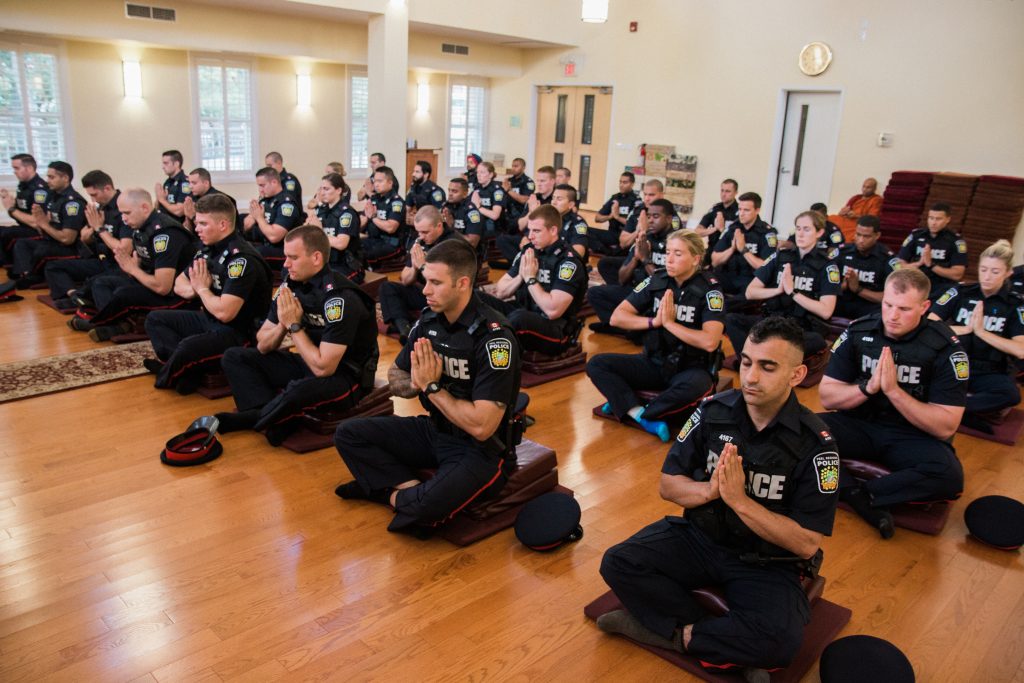
Features
Holding the Line
Experiencing mindfulness our way as first responders
November 23, 2019 By Michelle Vincent
 Photo: Peel Regional Police Service
Photo: Peel Regional Police Service Mindfulness has become a popular method and tool for mental health when we are stressed, starting our day or preparing for sleep. It is used to release the grip on challenging thoughts as well as preparing us for high performance-based activity. Meditation, an aspect of mindfulness, has us notice the thoughts that come to mind and proceed to let them go, allowing for a flow of the present moment.
As police officers and civilians in a policing environment, mindfulness may be a part of our curriculum, depending on our organization. While implementing mindfulness in training for police and civilians is a powerful tool in the toolbox, understanding its parameters and limitations in terms of its strengths and weaknesses is essential if we are to respect the relationship between trauma and mindfulness.
There are a number of articles discussing the pros and cons of mindfulness. Some of these works consider it to be key in managing mental health issues such as anxiety and depression. Others caution the way in which mindfulness is applied, especially in first responders. Understanding the brain that has experienced significant trauma—as many first responders have—is especially important when considering mindfulness.
One author and expert on mindfulness, David Treleaven, discusses the myths on mindfulness, including: the belief that “one size fits all,” knowing when we, or someone else, is struggling or experiencing trauma; and the ideas that the breath is neutral. Treleaven explains the neurobiology of a traumatic experience and a reaction such a person practicing mindfulness may need. He also touches on the need for modification to mindfulness in these instances. Engaging in this practice may be most effective with a trainer/educator/therapist who understands what modifications would best support each individual, dependent on their exposure to trauma. This is something we can ask as we begin our practice.
Another myth Treleaven explains is the notion that the mindfulness guide will always know when those practicing are being traumatized. Research has found that trauma can induce shame. Mindfulness can also induce shame and embarrassment if the individual feels they are not “doing it right.” If we blend this with the desire to please the guide who is conducting the mindfulness practice, the likelihood of a submissive aura may inhibit our experience. It could lead to us believing or feeling that this mindfulness practice just isn’t working for us.
The final myth Treleaven shares is about the breath in relation to mindfulness. It is not always neutral. Our respiratory system is interconnected with our sympathetic nervous system, he explains, which, from a sensory perspective as breath is, may relate to our experience of trauma. Many of us can relate to smells, sounds and experiences that bring back challenging times on the job. Asking one to focus on the breath has the potential to retraumatize one who has experienced significant trauma.
Deconstructing these myths is not to have us all overthinking mindfulness within the realm of mental health. It is to inform us so whether we are experiencing challenges, negativity, trauma or our colleagues are brave enough to mention such an experience, we can inform them of the normalcy—as well as the potential for modification—so they or we can experience the true power of mindfulness.
Instead of leading with the breath, we can choose different options around an anchor point, allowing us to feel empowered, Treleaven states. We can choose the breath, the sound in our environment (such as the hum of an air conditioner), and other sensations (such as resting our hands on our legs). Trying different anchors and allowing choice supports the power/practice of decision-making in our own treatment using mindfulness. Empowerment is key! Let’s leverage the full power of healing in our trauma-based world as first responders and experience mindfulness our way.
For further information, listen to David Treleaven’s free webinar and resources available at davidtreleaven.com.
Michelle Vincent is an 18-year York Regional Police officer with a master of arts in counselling psychology and a background in equine-assisted therapy, workplace reintegration after a critical incident and long-term leave, as well as teaching. She is in the process of implementing the first non-profit treatment centre that will be occupationally specific for first responders and is working towards her PhD in Forensic Psychology/Crisis Response. She can be contacted at: michelle@smith.net.
Print this page